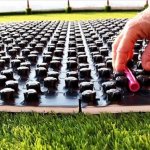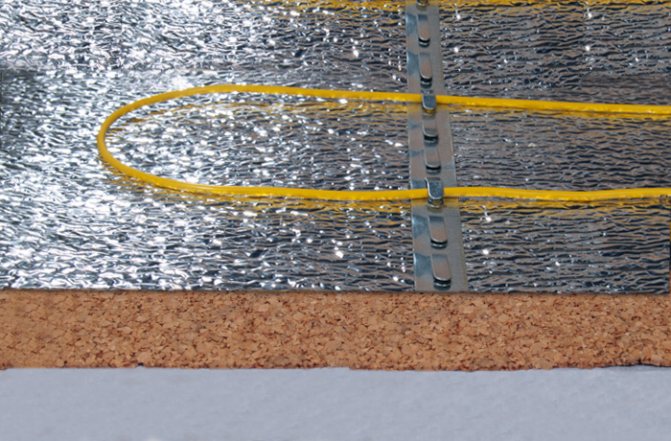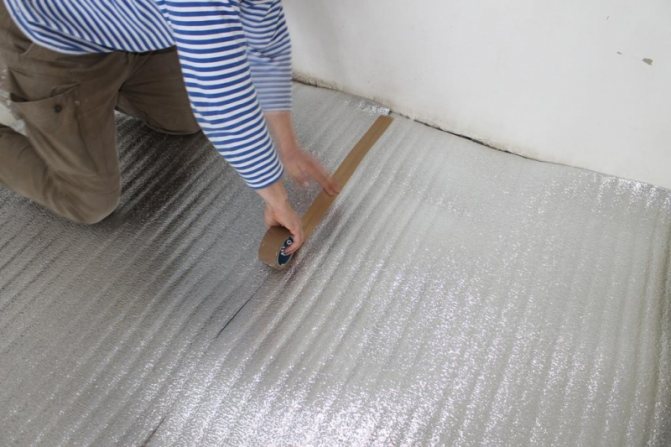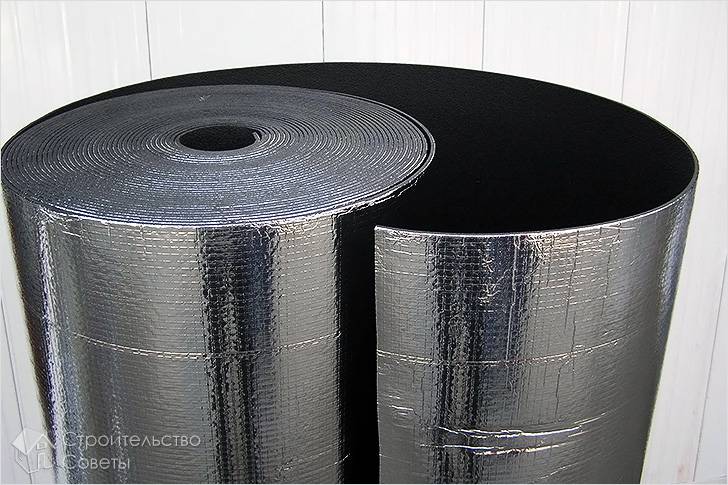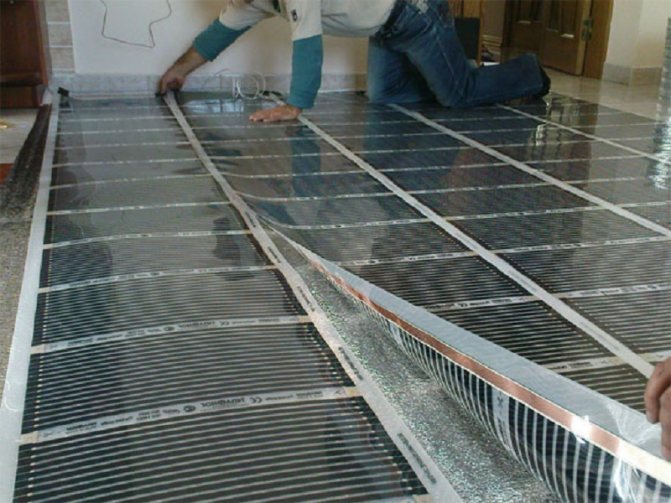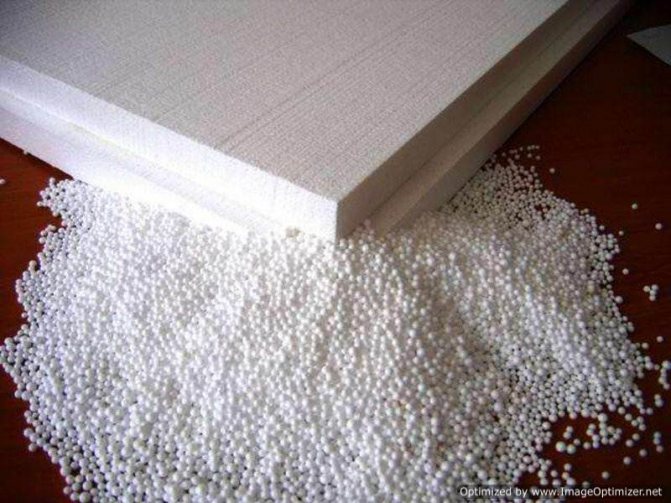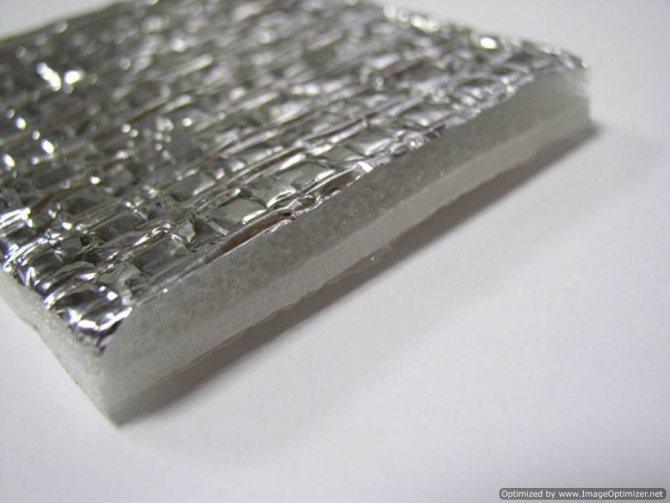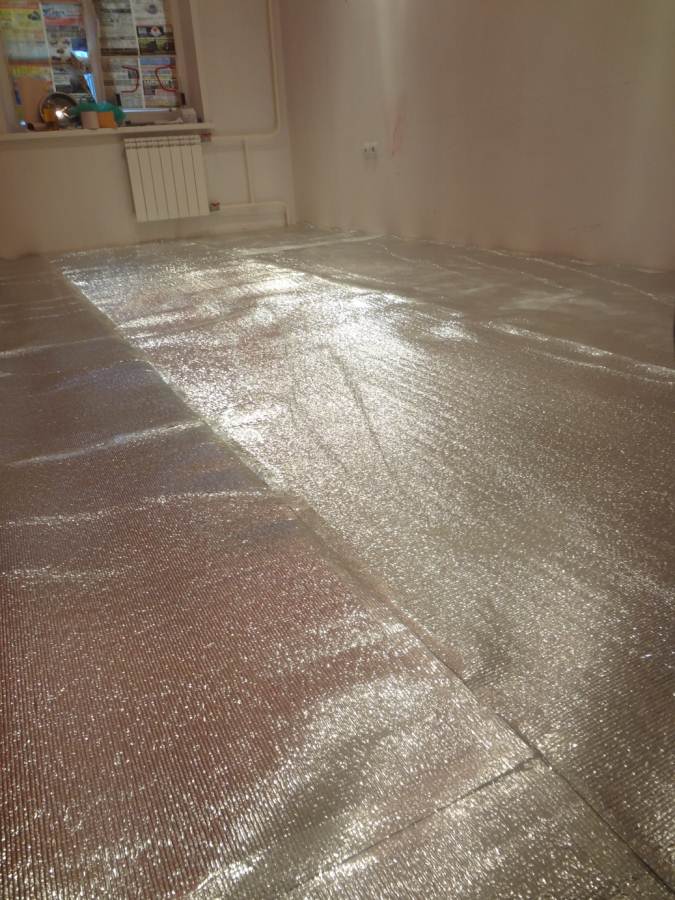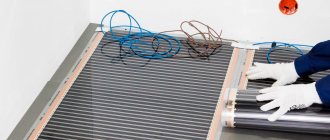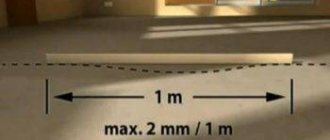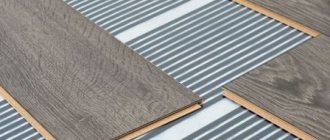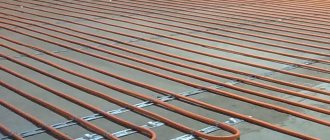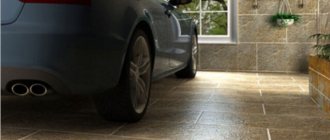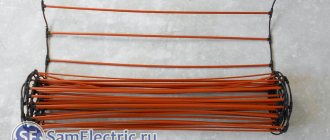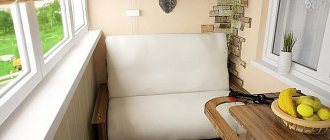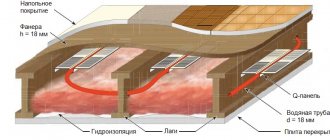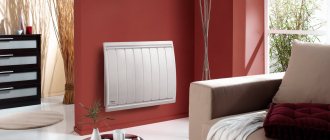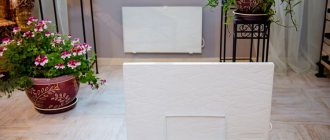With lugs
Rectangular very high density expanded polystyrene foam mat... Substrate thickness from 10 mm to 35 mm. The lugs are cylinders or cubes 20–25 mm high. Pipes with a diameter of 14 mm to 20 mm are laid between the lugs. The protrusions serve as a reliable lock when pouring the mortar. The risk of the pipes moving is zero.
Attention
The price of the material with bosses is higher than for ordinary polystyrene foam mats, but it pays off during installation.
Benefits:
- curly protrusions facilitate pipe laying and fixation;
- additional fastening of pipes, extra layers before pouring the screed does not require;
- helps to evenly distribute the heat-conducting elements of the system;
- provides high noise, heat and waterproofing.
Boss slabs are available in both conventional and laminated mats. Conventional ones have low thermal insulation properties and are more suitable for a frame for laying pipes.
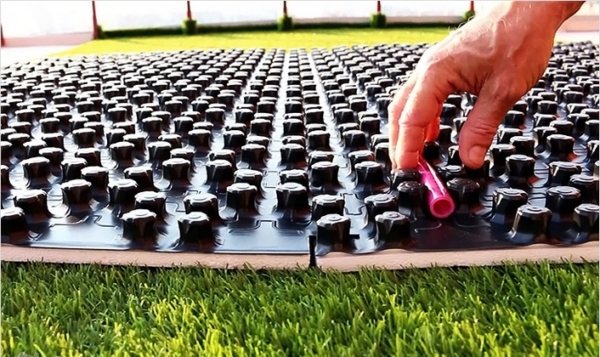
Foil
Products based on:
- plate extruded polystyrene foam;
- foam;
- polyethylene;
- cork material.
Advice
Foil film provides an increase in the technical characteristics of any base material, transfers its reflex qualities to it.
Aluminum and lavsan are used as a reflective outer coating. Depending on the thickness of the foil layer, the degree of heat-reflecting properties changes. Lavsan is highly resistant to aggressive environmental conditions - even with prolonged contact with a concrete screed, its reflective function and water resistance are preserved.
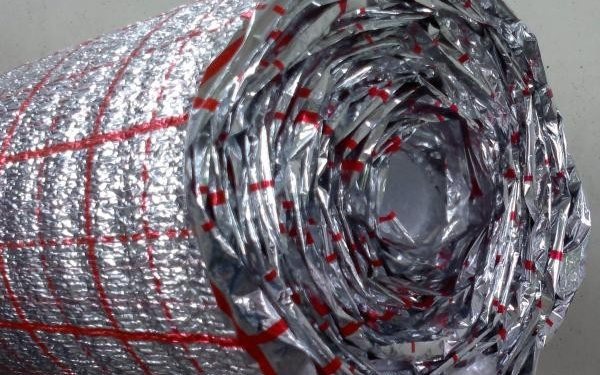

How to achieve maximum heat dissipation
When developing any heating structure, the main goal is its maximum heat transfer, but this is not always achieved when using one device without auxiliary materials or devices. Therefore, the installation instructions for heating circuits suggest a number of measures aimed at increasing efficiency, that is, obtaining a higher room temperature with minimal energy consumption.
Varieties of warm floors
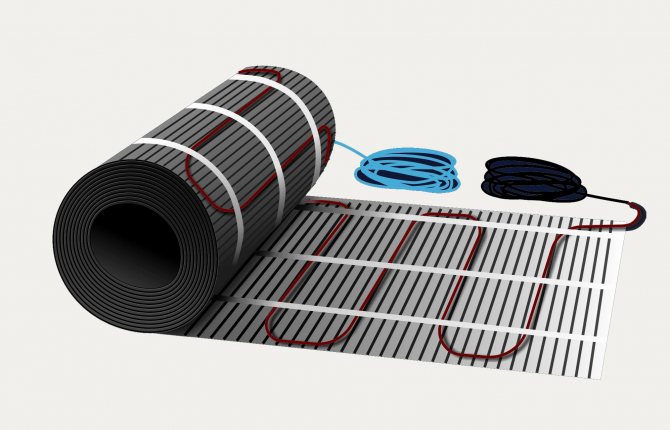

Electric underfloor heating mats
Electric underfloor heating systems can be divided into three main types: a heating cable, the same cable, only fixed on special mats, and infrared film heating (IPO). Different for all three structural devices is not only their price, but also the methods of heating the room. The most significant difference can be traced between IPO and heating cables..
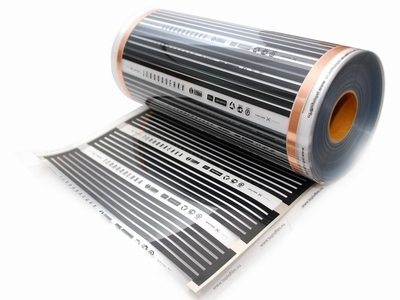

Infrared film heater
The difference is that the cable heats up by itself, and the IPO sends out radiant infrared energy in a directional way, from which objects are heated and, as a result, heat the room. In the same way, a person, being a physical body, receives a dose of IR radiation, so he is warm. At the same time, the air does not heat up in the same way as it happens with convection heaters and remains cool, which is good for the health of the layman in the room.
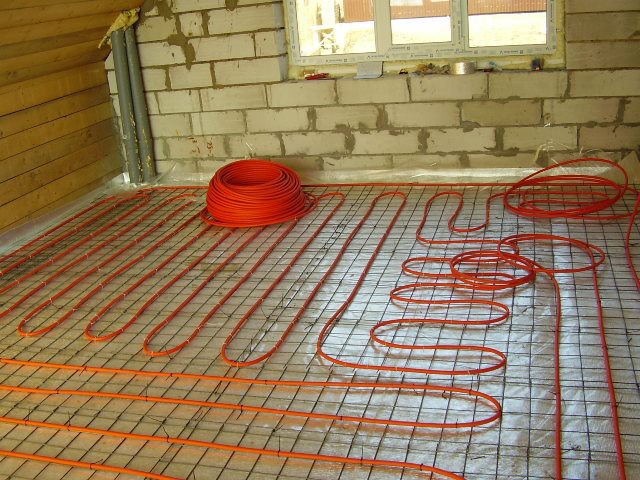

Polyethylene pipe for water floor
Water heated floors have a convection heating method, but, nevertheless, their efficiency and environmental friendliness are not lower than that of electric ones. Installation of such a circuit is carried out either with a metal-plastic or polyethylene (see photo above) pipe, but this does not affect the floor arrangement in any way, so we will not focus on this.
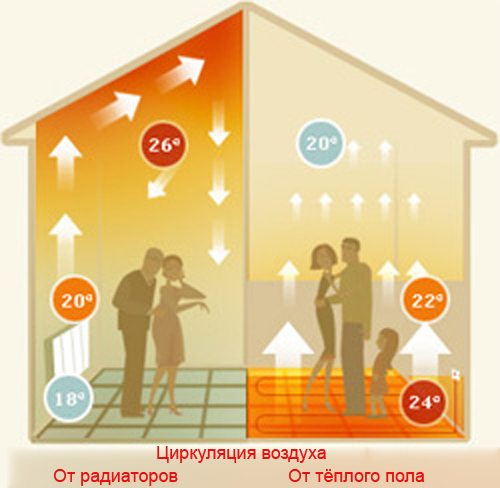

Air circulation diagram from different heating circuits
In any case, if you prefer a warm floor to a radiator circuit, regardless of its type and type, you get a healthier atmosphere in the room. This means that the temperature at the bottom of the room will always be higher than at the top, and this is the best option for human health, and for comfort in general.
Foil reflectors
Folgoizolone
First of all, one should not confuse a foil-clad reflector for any heating system with a material such as a substrate for a laminate on a warm floor. They perform completely different functions, although sometimes the same material is used for their manufacture - polyethylene foam.
But if the purpose of foil-clad insulation is to reflect heat fluxes, then the substrate for the laminate, on the contrary, is to restrain them, but here, too, everything is not as simple as it might seem at first glance.
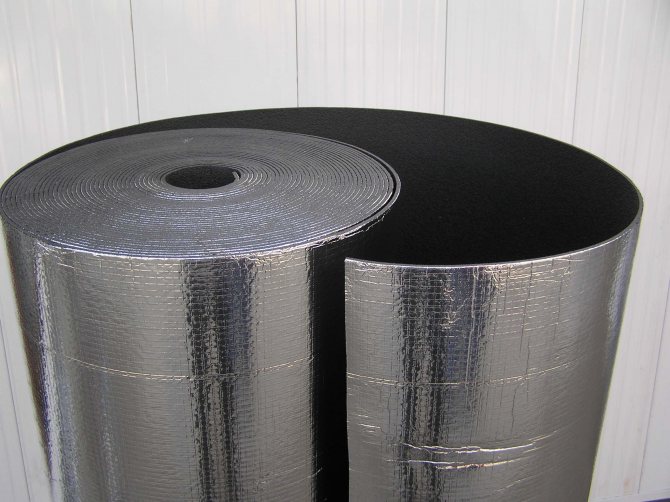

ALUFOM
Let us consider, using the example of reflective insulation ALUFOM, whether it is needed for a warm floor in general and how it works.
- There are two types of such products, they are ALUFOM AL, where the foil is made of aluminum and ALUFOM PE with metallized propylene film. For the base and in one and in the other case, NPE is used - foamed polyethylene.
| Parameter name | ALUFOM AL | ALUFOM PE |
| Thickness of aluminum foil in microns | 16 (+- 2) _ | — |
| Polypropylene film thickness | — | 40 (+-5) |
| Thermal conductivity coefficient (W / m t⁰C) | 0?038-0?051 | 0?038-0?051 |
| Application temperature (t⁰C) | -60⁰C to + 100⁰C | -60⁰C to + 100⁰C |
| Thermal reflection coefficient | 0,97 | 0,95 |
| Sound absorption in dB, not less | 18 | 18 |
| Flammability | G1, D3 | G2, D3 |
| Water vapor permeability mg / (m h Pa) | 0 | 0 |
Table of technical parameters ALUFOM
- As you can see, the parameters of the materials in one and the other case are very similar, therefore, both metal and aluminum are suitable as a heat-reflecting substrate for a warm floor. The goal here is to prevent the waste of thermal energy on the base, that is, so as not to heat the cement-sand or concrete screed underneath.
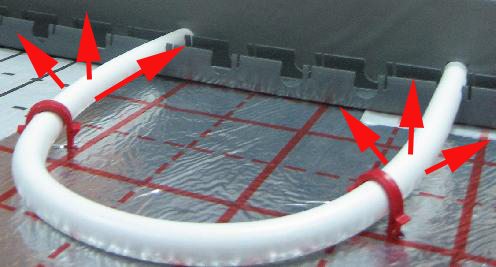

The direction of heat flows from the water circuit of the floor
- But here, too, everything is not so simple. Heat flows from a water pipe or from an electric heating cable rise through the screed in the form of a funnel at an angle of 45⁰, gradually sloping towards the horizontal line, so that heat is transferred downward mainly at the molecular level, due to close contact. Aluminum or metal cannot be insulators here, because they themselves are excellent conductors, but under them there is foamed polyethylene, which creates a thermal barrier due to air-filled pores.
- But what is the role of the foil in this case, if it is itself a conductor ?! The fact is that the substrate under an infrared warm floor or any other, on which there is a layer of foil, has the ability to reflect infrared rays. Thus, depending on the temperature, room size and air humidity, such insulation increases the heating efficiency from 20% to 70%.
Advice. If for a conventional (non-IPO) heating circuit you can use insulation with a metallized propylene film, then the best substrate for a film warm floor will be the one where there is a layer of aluminum foil. So all infrared streams will be used on the premises.
Installation
Laying foil-clad polyethylene foam on the floor
Insulation of this type, whether it is a substrate under a laminate for a warm floor or under the contour of a warm floor, always fits in the same way - either overlapping, or butt-to-joint. You can see that there are two completely different installation methods offered, but this, first of all, depends on the thickness of the material, that is, the insulation.
Foamed polyethylene, with a layer of foil glued to it, can have a thickness of 2 to 20 mm and of course, a layer of 20 mm with an overlap cannot be laid - the differences in the plane are too large, despite the fact that it is compressed.
But if the thickness of foamed polyethylene foam is from 2 mm to 6 mm, then without hesitation, you can run it on top of each other, only the joints are best fixed with tape so that the flooring does not move when installing the pipe and brackets for it.However, it makes no sense to lay a thicker reflector on the floor under the laminate, because an overly soft pillow will turn out, which will have a negative effect on the upper screed, and it may crack from deformation.
Therefore, if additional insulation is required, sheets of extruded polystyrene foam are laid under thin foil-clad polyethylene foam, the thickness of which will depend on the need for thermal insulation power.
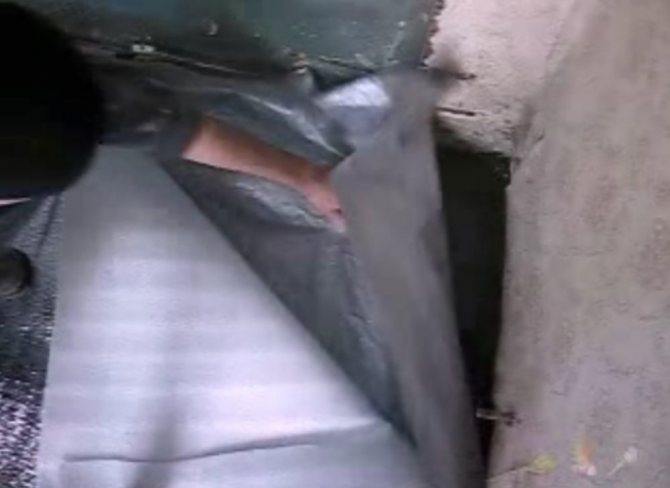

Hydro-barrier under reflector
Advice. If you are laying foil-clad polyethylene foam on a concrete floor or on a screed in which there is no waterproofing (or you do not know about its presence or absence), then place a hydro-barrier or ordinary dense cellophane film under the reflector.
Styrofoam
Industrial foaming of polystyrene forms the material of expanded polystyrene... The finished product consists of only 2% of the main substance, auxiliary additives and 98% of gas. The air is contained in hermetically welded cells, which gives the material good thermal protection properties.
Important
Expanded polystyrene with a thickness of 10 cm in terms of thermal conductivity is similar to wood with a layer of 35 cm, in a reinforced concrete wall at 480 cm, in a brick wall - 150 cm.
Benefits of expanded polystyrene:
- low thermal conductivity;
- high water resistance;
- low moisture absorption;
- resistance to deformation.
Of the shortcomings, they note:
- low soundproofing ability;
- flammability;
- deformation when exposed to kerosene, solvents, turpentine, acetone.
It is not recommended to use unpressed or autoclaved polystyrene foam due to their increased fragility.
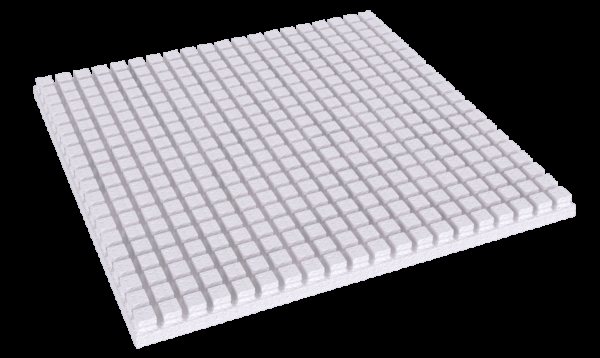

Selection of a substrate for a warm floor of an electrical system
The underfloor heating electrical system consists of a two-core cable, heat sensors and a heat regulator. The principle of operation of an electric underfloor heating is that when the cable is heated, when an electric current passes through it, the heating element heats up and the floor is heated.
The best types of underlays for electric warm floors:
- Expanded polystyrene;
- Vacuum sprayed polyethylene film;
- Heat-reflective foil backing;
- Backing made of foil-coated mylar film sheets.
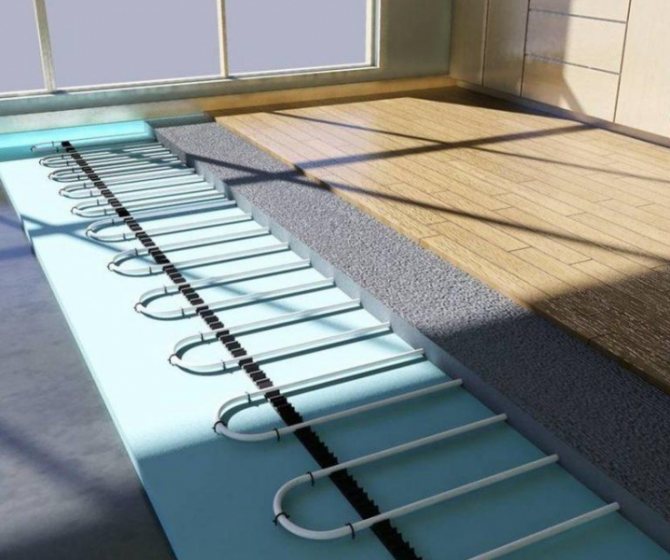

The electrical system of the underfloor heating consists of a two-core cable, heat sensors and a heat regulator
Related article: Distance from floor to window: calculation
Nowadays, the industry has decided to simplify the installation of underfloor heating and began to produce already completely ready-to-install, electric heating mats in which an aluminum mat is included, the thickness of which will be optimal. In this case, it is not necessary to lay the underlay. The joints between the wall and the floor, as in the case of installing an infrared heat-insulated floor, must be insulated with a special self-adhesive insulating expansion tape. It not only perfectly insulates against heat loss, but is also an excellent noise and sound insulator.
On top of the thermal electric floor, sheets of fiberboard or plywood are most often laid and the finishing coating is laid - laminate, linoleum, parquet, parquet board. Fiberboard or plywood will perfectly protect the heating elements of a warm electric floor from damage. They do an excellent job with such a lack of such floors, such as poor sound insulation.
Heat reflective
Polypropylene is an excellent material for insulation... For laying under warm water floors, polypropylene is chosen, which has a special foil or metallized layer of lavsan. The metallized or foil-coated component has high heat-reflecting properties, so the heat does not go down.
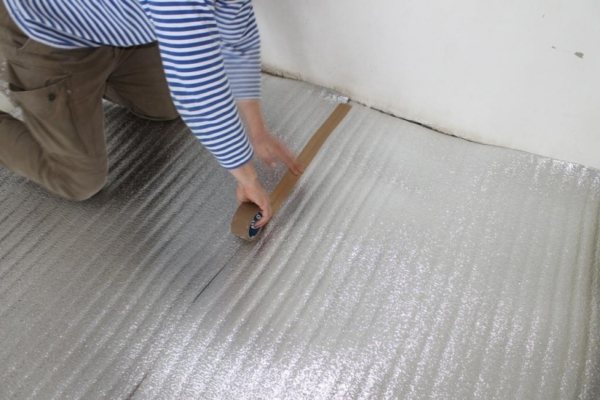

Material selection
Usually, the material for the lining under the heating elements becomes polyethylene foam or
Foamed backing.
polypropylene, which, moreover, are covered with a lavsan film with a layer of metal spraying. The metallized coating helps the heat to be evenly distributed under the floor covering, and the insulation itself does not allow the heat to be absorbed by the screed.
Foam underfloor heating has a low degree of thermal conductivity, which prevents heat from leaving the floor and screed. The temperature limit of the material (up to 90 degrees) allows laying pipes or heating cables directly on the foil. Together with excellent thermal and waterproofing properties, the layer of such material also has excellent sound insulation. It should also be borne in mind that the marking applied to the substrate will allow laying the cable according to the calculated step, this will increase the accuracy of work and a reliable result.
Metallized film
Attention
The metallized film is obtained by combining three layers of polystyrene foam (lavsan, cork material, foamed polyethylene), foil and polymer film.
This film has a high density, which ensures reliable fixation of fasteners. Suitable for installation under all types of warm floors, including under water.
Benefits:
- heavy duty;
- quickly restores its original form;
- resistant to fire, temperature changes;
- can be laid on uneven surfaces;
- easy to assemble;
- retains its heat-reflecting function for a long time.
Of the minuses, they note:
- afraid of moisture, it is necessary to lay waterproofing over the substrate;
- additional pipe fittings are required.
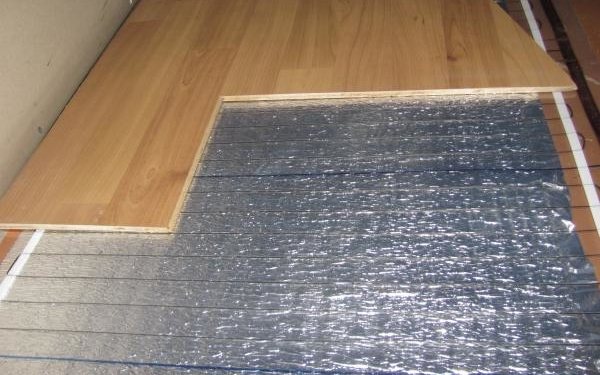

Instructions for self-installation of a film underfloor heating
Having determined the exact location of the sheets of underfloor heating material, it is necessary to prepare the work surface for further actions.
The old floor covering is carefully removed from the floor surface (the material can be used twice), and the concrete base is thoroughly washed, cleaned of dust and debris.
If necessary, cracks and potholes in the concrete surface can be repaired with a special mortar.
Further installation of the film floor is carried out in several stages:
- Cover the floor surface with a layer of heat-reflecting material. Moreover, it is recommended to process not only the "working surface", but also to capture the remaining space in order to avoid the occurrence of irregularities and drops.
The sheets are placed joint to joint and additionally glued with tape, excluding the formation of empty gaps. - Prepare sheets of thermal film of the required size (preferably no more than 7 meters). Remember that the film is allowed to be cut only in special areas in increments of 25-30 cm to avoid system damage.
Lay out the sheets of material in this way:
- contacts should be directed to the wall where the temperature sensor is planned to be installed;
- when the sheets are laid correctly, the copper strips will be face down;
- leave a distance of 1-2 cm between the sheets.
This action helps to shorten the length of the wires used to connect the film to the sensor.
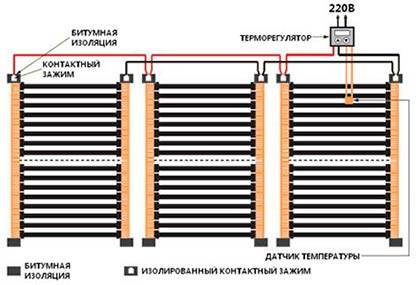

- Attach the clip to the copper strip of the thermal foil, positioning it on both sides of the sheet, and carefully insulate the cuts.
- Check the quality of the fastening of all wires and the reliability of the insulation of all connections and cut lines.
Install the temperature sensor on the wall in the most convenient and accessible place, and then connect the electrical wiring. Also connect the sensor to the thermal film in an area with a minimum surface load. - Connect the device to the mains and check the system for arcing and overheating of the connections.
As the final step in the installation of an infrared underfloor heating, lay a protective film or underlay on top of the film, and then start installing the floor covering.
Cork
The cork lining contains crushed compressed bark pellets and binders. Produced in separate sheet mats or rolls.Thickness in rolls - 2–4 mm, in sheets - 4–10 mm.
Cork advantages:
- natural, environmentally friendly;
- hypoallergenic;
- resistant to deformation, quickly returns to its original shape;
- has high noise insulation due to porosity;
- good thermal insulation;
- easy to cut and lay.
Cons of a cork product:
- afraid of water;
- waterproofing over the substrate is required;
- does not withstand large static loads.
In addition to the cork lining, there is a rubber-cork lining with rubber. Waterproof, with increased sound and vibration isolation, it is more suitable for a warm water floor. However, it is no longer completely natural.
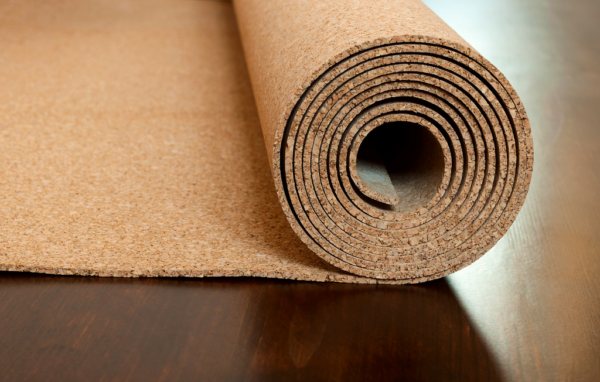

Penofol
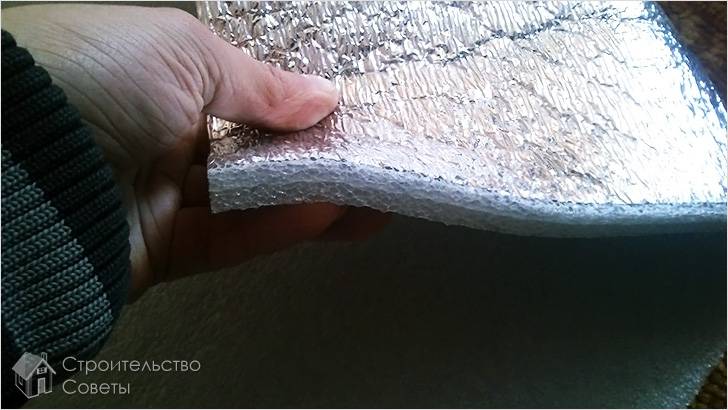

Another heat-insulating material that can be used in a warm floor system is penofol or polyethylene foam. It is sold in rolls, with a thickness of 3 to 10 mm. The foil coating can be marked for laying heating circuits.
If there is a room or basement below that is not heated, then the thickness of the foam is not enough and an additional layer of expanded polystyrene must be laid.
As for the use of penofol in the underfloor heating system, there are some nuances. The cement that covers the heating circuit system is corrosive in its liquid state. The alkaline environment of the screed corrodes the foil. What to do in this case? There are several ways to solve this problem:
- Buy that thermal insulation that has metallized foil, but not aluminum.
- Purchase foil, which is already covered with a polyethylene layer in the kit. Its price is slightly higher.
- The simplest option is to lay simple polyethylene on top of the foil, on top of which you can pour a screed.
In the form of mats
Styrofoam mats are covered with foil or foil, sometimes with both materials. They have the advantages of expanded polystyrene boards, but are improved by the presence of several layers.
Advice
On some models, the film has a self-adhesive backing, protected by a backing. When installing these mats, you do not need to use waterproof tape.
Mats are realized in the form of panels, but for ease of installation it is better to take them in separate fragments in order to easily fit to each other and connect using a foil film covering, produced in the form of a roll. The mat backing allows a large surface area to be covered immediately. Harpoons are used to attach pipes to mats. But you can also use mounting strips tied to the reinforcing mesh.
Installation of polystyrene mats is quick and easy... For example, without a screed construction, it will take about an hour to install a substrate in a 10-15 m2 room.
Foamed polystyrene mats are made by hydropellant stamping, the density of the products is 40 kg / m3, the thickness is from 20 mm to 50 mm.
Clips or tapes are used to connect the mats. With this method of connection, hollow seams are not formed, the noise level is reduced to 25 decibels.
Here are the advantages:
- no fixing hardware required;
- it becomes possible to quickly lay heating circuits;
- easy assembly speeds up installation;
- consumables are included with the mats.
The disadvantages include the inability to lay pipes with a diameter of more than 20 mm.
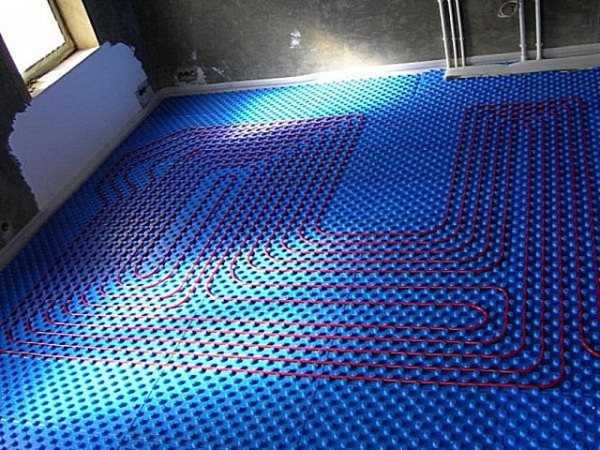

Laying technology
Laying the substrate is an important step in the arrangement of infrared warm floors. Therefore, when installing it, it is required to follow a number of rules:
- when using sheets of fiberboard or magnesite plates, you should first cover the screed with aluminum foil;
- in cases with a polymer metallized film, its reflective side should be located upward;
- the insulating material must cover the entire surface of the heated room.
As with the installation of the substrate in the "pie" of any warm floor, the lining for the infrared film is mounted on a clean base equipped with a vapor barrier (polyethylene).
Insulation spreads over the entire area of the room, reflecting side up, with a distance of 100 mm from the walls. These openings are closed with a damper tape. The joints are glued with a special metallized tape. So that the material does not move when the floor is in operation, it is attached to the base with double-sided tape.
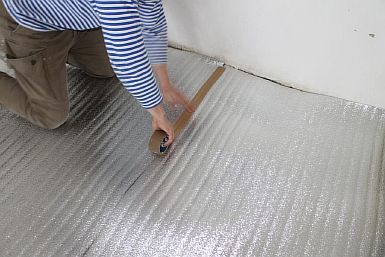

After that, the infrared film is mounted; there should be no air gaps between it and the substrate. Then the topcoat is applied.
The efficiency of the floor, and therefore the comfort in the house, depends on a correctly and well-laid substrate.
Expanded polystyrene smooth boards
Often, the underfloor under the warm water floor is made with smooth polystyrene foam plates for the underfloor heating system. Thickness - 4–5 cm, density - 40 kg / 1 m3, resistant to deformation. To protect the slabs from the aggressive effects of the concrete mixture, before pouring the screed, they are covered with plastic wrap. The pipes are easily attached to the slabs with plastic brackets.
Important
You can use polystyrene foam boards under a warm floor, which serves as the main heating of the room. The downside is the lack of markup on it. You will have to do it yourself before laying the heating circuit.
Advantages of expanded polystyrene boards:
- have a strong vapor barrier polystyrene foam layer, so condensation does not form;
- if there is a foil laminated coating on the plates, you can not be afraid to spoil the material with chemicals in the composition of the screed;
- easy to fit due to light weight and size;
- equipped with locks on the sides - there are no acoustic and cold joints when joining the plates;
- durable with proper operation - about 50 years;
- do not change the thickness under the weight of the screed.



